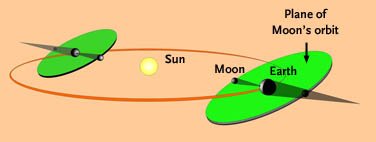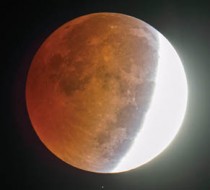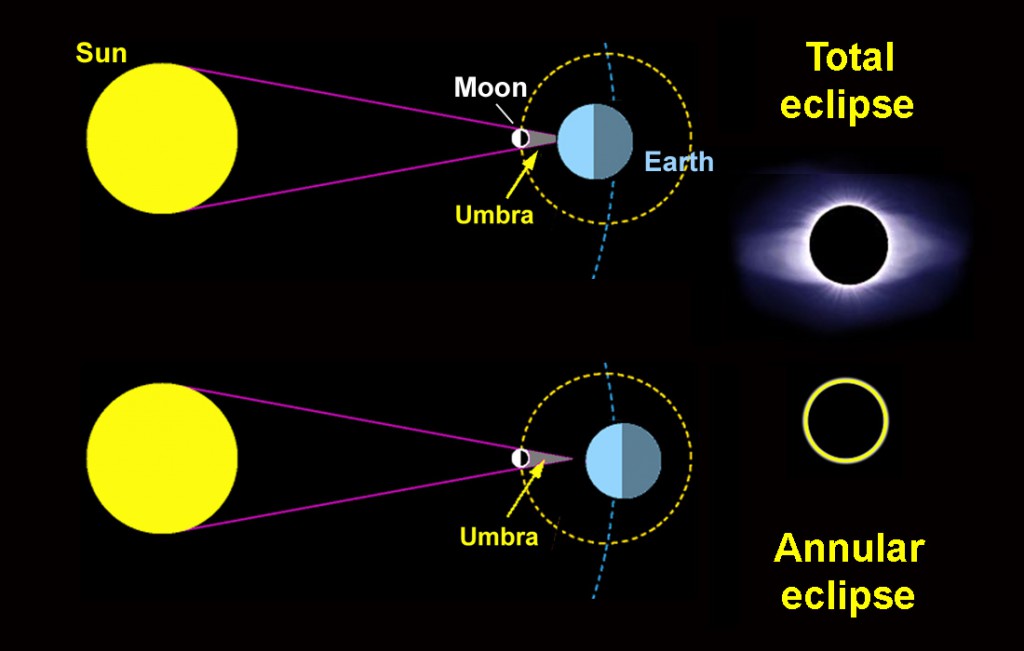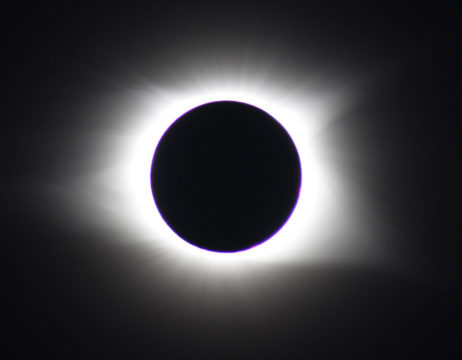Although no total lunar eclipses occur this year, skywatchers can look forward to two “central” solar eclipses — including a much-awaited total eclipse that spans the U.S. from Texas to New England.

Fred Espenak
Up to seven eclipses of the Sun and Moon can take place in one year, though the last time that happened was 1982, and the fewest possible is four.
During 2024 we’ll experience the four-event minimum. There’ll be a total solar eclipse in April (which crosses North America) and an annular solar eclipse in October, but 2024’s two lunar eclipses will be barely noticeable. It’s a very similar pattern to what took place in 2023. You can go directly to the circumstances of this year’s events if you wish — or continue on to explore some eclipse basics.
Find everything you need to know about the April 8th total solar eclipse — including what to look for, eclipse-day weather, events and lodging, and activities for kids and adults alike — in our eclipse portal.
Why Do Eclipses Happen?

Jay Anderson
A solar eclipse, such as the one seen coast to coast across the U.S. in August 2017, occurs only at new Moon, when the lunar disk passes directly between us and the Sun and consequently the Moon’s shadow falls somewhere on Earth’s surface.
Conversely, a lunar eclipse takes place during full Moon, when our satellite passes through Earth’s shadow.
These alignments don’t happen at every new and full Moon because the lunar orbit is tipped about 5° to Earth’s orbital plane — only occasionally do the Sun, Earth, and Moon line up exactly enough for an eclipse to occur. (The technical name for that, by the way, is syzygy.) And, as the diagram above implies, those alignments occur roughly a half year apart. So since the last eclipse of 2023 occurred in mid-October, the first eclipse of 2024 doesn’t take place until April 8th.
Lunar Eclipses
Three types of lunar eclipse are possible — total, partial, and penumbral — depending on how deeply the full Moon plunges into or near the umbra, our planet’s dark, central shadow.

Johnny Horne
If the Moon goes all the way in, we see a total lunar eclipse that’s preceded and followed by partial phases. That was the case during the widely viewed event in September 2015, which marked the conclusion of a series of four consecutive total lunar eclipses! Such eclipse tetrads are not common — the last one occurred during 2003–04, but the next won’t begin until 2032.
If the Moon ventures just partly into the umbra, as pictured here, only partial phases occur — you’ll see some of the Moon in nearly full sunlight, and some of it steeped in the deep, red-tinged umbral shadow.
And if its disk passes just outside the umbra, the Moon still encounters the weak penumbral shadow cast by Earth. A sharp-eyed observer will notice that one side of the full Moon’s disk looks a little dusky. All four of 2020’s lunar eclipses were of the penumbral variety.
Fortunately, every lunar eclipse is observable anywhere on Earth where the Moon is above the horizon. (But there’s still an element of luck involved — after all, the sky has to be clear!)
Solar Eclipses
Annular and total solar eclipses require the Moon to cross directly in front of the Sun as seen from Earth — and, as the graphic below shows, such “central” solar eclipses can only occur within a two-week-long interval when the Moon crosses the ecliptic during one of its two nodal crossings each year. However, the geometric window for partial solar eclipses is wider, roughly five weeks long.

Jay Anderson
If the Moon completely hides the Sun, the eclipse is considered total. With its brilliant disk completely covered, the Sun’s ghostly white outer atmosphere, called the corona, is momentarily revealed for durations from seconds to several minutes.
Occasionally the Moon passes directly in front of the Sun but doesn’t completely cover it. When that occurs, it’s usually because the Moon is farther from Earth than its average distance. (The Moon’s orbit isn’t perfectly circular; its eccentricity is about 5%.) This geometric circumstance is known as an annular eclipse, so-called because you can see a ring, or annulus, of sunlight surrounding the lunar disk. Annular eclipses of the Sun occur about as often as the total ones do.

Sky & Telescope
Unlike total lunar eclipses, which can be viewed from roughly half of Earth’s surface, total and annular solar eclipses tightly restrict where you can see them because the Moon casts a much smaller umbral shadow than Earth does — and you need to be within that shadow to view the event. A completely eclipsed Sun can be viewed only from a narrow track or path on Earth’s surface that’s typically just 100 miles (160 km) wide. Outside of that path, about half of the daylit hemisphere of Earth is able to watch a partial solar eclipse as the Moon obscures a portion of the Sun.

Sky & Telescope / J. Kelly Beatty
Getting to the path of a total or annular eclipse often involves long-distance travel. In November 2013, for example, planeloads of eclipse-chasers thronged to a remote corner of northern Kenya to watch just 11 seconds of totality. On December 4, 2021, some 15 cruise ships converged on the eclipse path in a remote stretch of the Southern Ocean hundreds of miles northeast of the Antarctic Peninsula. Yet only one of those ships succeeded in dodging the early morning clouds and glimpsing totality. What dedication!
Every location on Earth experiences a total solar eclipse every 375 years on average, with the Northern Hemisphere enjoying a slight statistical advantage right now. (To explore the worldwide distribution of total solar eclipses more closely, check out Sky & Telescope’s beautiful eclipse globe.)
The Four Eclipses of 2024
Below are brief descriptions of the four eclipses that take place in 2024. You’ll find more details in Sky & Telescope magazine or on this website as the date of each draws near. Times are given in Universal Time (UT) except as noted. Adjust these to get those for your time zone: for example, PST = UT – 8, and EST = UT – 5. (But be sure to allow for daylight or “summer” time, when PDT = UT – 7, EDT = UT – 4, and so on.)
| Date | Type | Maximum | Visibility |
| March 25 | Penumbral lunar eclipse | 7:13 UT | North and South America |
| April 8 | Total solar eclipse | 18:17 UT | North America |
| September 18 | Partial lunar eclipse | 2:44 UT | North and South America, Europe, Africa |
| October 2 | Annular solar eclipse | 2:44 UT | S. Pacific Ocean, S. South America |
March 25: Penumbral lunar Eclipse

Sky & Telescope / Leah Tiscione
The year’s first event is a geometric oddity. The Moon will glide deeply into Earth’s penumbra, our planet’s weak outer shadow, but not the umbra. From the perspective of astronauts standing anywhere on the Moon’s nearside during this event, they’d see the Sun partly — but not completely — blocked by Earth. We see this drop in sunlight as a dusky shading on the lunar disk that gets gradually more obvious as the Moon dives deeper into the penumbra. If you watch this event, try to determine when you can first detect that penumbral shading.
This eclipse favors observers in the Americas. In the U.S., mid-eclipse occurs in the first hours of March 25th for those on the East Coast (mid-eclipse will be at 3:13 a.m. EDT) and just after midnight for those on the West Coast (where the eclipse begins in late evening on March 24th).
April 8: Total Solar Eclipse
Two weeks after March 25th’s barely-there lunar eclipse, after the Moon has swung around to the opposite side of its orbit and becomes new, it crosses directly in front of the Sun to create a total solar eclipse. Millions of Americans who witnessed totality in August 2017 have been eagerly awaiting this second act. And it’s notable in two ways: First, totality will last up to 4m 28s, a duration that ranks as the eighth longest in the 21st century. Second, it will be the last total solar eclipse observable from the contiguous United States until 2044. So, in the minds of many skywatchers, it’s an event not to be missed.

Sky & Telescope / Leah Tiscione
This year’s path falls almost completely within the northern half of the Western Hemisphere. The Moon’s umbral shadow first touches Earth in the central Pacific Ocean and sweeps toward the northeast for 85 minutes before making landfall in Mexico and passing directly over the popular resort city of Mazatlán. Twenty minutes later the umbral shadow crosses the Rio Grande at the Mexico-U.S. border. At that point it’s a broad 195 km (121 miles) wide and racing along supersonically at 0.7 km per second (1,600 mph).
Unlike the path during 2017’s total solar eclipse, which crossed the U.S. from northwest to southeast, this year’s south-to-northeast track carries it over quite a few large cities — among them Dallas-Fort Worth, Indianapolis, Cleveland, Buffalo, and Montréal. In fact, according to master cartographer Michael Zeiler, nearly 13 million people live within the path of totality in Texas alone!
In the table below are the key times for 10 representative locations in North America that will witness a total solar eclipse, given in local time (24-hour format):
| City | Eclipse begins | Totality begins | Totality ends | Eclipse ends | Totality duration |
| Mazatlán, Mexico | 9:51 | 11:08 | 11:12 | 12:321 | 4m18s |
| Austin, Texas | 12:17 | 13:36 | 13:38 | 14:58 | 1m52s |
| Dallas, Texas | 12:23 | 13:41 | 13:44 | 15:03 | 3m49s |
| Carbondale, Illinois | 12:43 | 13:59 | 14:03 | 15:18 | 4m8s |
| Indianapolis, Indiana | 13:51 | 15:06 | 15:10 | 16:23 | 3m50s |
| Cleveland, Ohio | 13:59 | 15:14 | 15:18 | 16:29 | 3m49s |
| Buffalo, New York | 14:05 | 15:18 | 15:22 | 16:32 | 3m45s |
| Kingston, Ontario | 14:10 | 15:22 | 15:25 | 16:34 | 3m2s |
| Montréal, Québec | 14:14 | 15:27 | 15:28 | 16:37 | 1m17s |
| Burlington, Vermont | 14:14 | 15:26 | 15:29 | 16:37 | 3m15s |
Eclipse specialist Fred Espenak, who supplied the table above, has computed local circumstances for hundreds of cities and also has an interactive map that provides them for any location.
As seen in the map below, the prospects for clear skies are excellent over Mexico, good over Texas, and less favorable farther to the northeast — after all, in early April it could be snowing in the Northeast U.S.

Jay Anderson
Early this year, regional weather systems will be dominated by warm El Niño currents in the eastern Pacific, which often result in wetter-than-average conditions from southern California to along the Gulf Coast. That’s a bad omen for eclipse-chasers. However, an analysis of decades of data by meteorologist Jay Anderson suggests that El Niño conditions might actually improve the chance of clear skies on eclipse day, particularly in Texas, Oklahoma, and Arkansas.
In any case, be sure to check out Sky & Telescope’s comprehensive guide to this eclipse, which provides links to online S&T articles and other sources that cover every aspect of viewing, recording, and enjoying solar eclipses.
September 18: Partial Lunar Eclipse

Sky & Telescope / Leah Tiscione
This event is a particularly deep incursion into the penumbra, culminating with up to 10% of the Moon’s diameter dipping into into the much darker umbra for roughly an hour. So an attentive observer should notice that the northern half of the lunar disk looks dusky and might have a small divot missing near its northern pole.
The Universal Time of mid-eclipse is 2:45 — quite early on September 18th — which means it will be seen before dawn that day in Europe and Africa. But for the Americas, this event takes place on the evening of September 17th. Those in the eastern U.S. and Canada — and all of South America — can watch the lunar dimming with the Moon relatively high in the late-evening sky; those on the West Coast will experience it in early evening, not long after sunset and moonrise.
This will be the last in a string of penumbral and just-barely-partial lunar eclipses that stretches back for nearly two years; the last total lunar eclipse was November 8, 2022. But the celestial alignments are about to improve, with three total and one not-quite-total lunar eclipses in 2025–26.
October 2: Annular Solar Eclipse
The year’s second solar eclipse comes two weeks after September’s partial lunar eclipse. It’s a long-lasting annular that will create a “ring of fire” for up to 7m 25s. That’s the good news. The bad news is that very few people will get a chance to see this spectacle, because the track of annularity is almost completely confined to the Pacific Ocean!

Sky & Telescope / Leah Tiscione
The most viable locations for observing October’s ring eclipse will be in the southern half of South America, the parts of Patagonia that are very sparsely populated overall. Even those hoping to see a partial solar eclipse that day will largely be out of luck — unless they already happen to be in Patagonia, crossing the Pacific on a cruise, or somewhere in Hawai‘i. From the summit of Mauna Kea, you’ll see a half-covered Sun about 30 minutes after sunrise.
But there is one other bit of land within the path of annularity that many devoted eclipse-chasers have known about for some time: the remote South Pacific island of Rapa Nui (known more widely as Easter Island) lies about halfway from the path’s centerline to its northern limit. If skies are clear that day, skywatchers there will experience just under 6 minutes of annularity when the Sun and Moon converge high in the midday sky.
Looking Ahead to 2025
Next year the recent minimalist eclipse trend continues, with just four in the offing once again. But the script flips: There will be two total lunar eclipses (the one on March 14th will be visible in the Americas), and two partial solar eclipses (neither visible from North America).
| Sky & Telescope offers great opportunities to view the solar eclipses in 2024 and beyond. Watch from a choice location in the Hill Country of Texas (where bluebonnets will be in full springtime bloom) or on a two-week cruise along the “Mexican Riviera” with eclipse viewing just off the coast of Mazatlán. And on October 2nd, don’t miss the chance to witness more than 6 minutes of annularity while standing amid the imposing moai of Easter Island. |
 0
0
Comments
You must be logged in to post a comment.